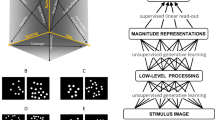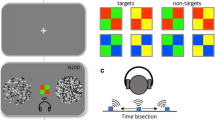Abstract
Two adult chimpanzees were trained on a relative “numerosity” discrimination task. In each trial, two arrays containing different numbers of red dots were presented on a CRT monitor. The subjects were required to choose the array containing the larger number of dots. In Experiment 1, using numerosities between 1 and 8, 28 different pairs were presented repeatedly, and accuracy scores were analyzed to explore which cues the chimpanzee subjects utilized to perform the task. Multiple regression analyses revealed that the subjects’ performance was (1) not simply controlled by the “numerical” difference between arrays, but that it was (2) best described by Fechner’s Law–that is accuracy increased linearly with the logarithmic value of the numerical difference between arrays divided by the number in the larger of the two arrays. This relationship was maintained when using much larger numerosities (Experiment 3). In Experiment 2, the chimpanzees were tested on the effects of total area and density by manipulating dot size and presentation area. The results revealed that these factors clearly affected the subjects’ performance but that they could not alone explain the results, suggesting that the chimpanzees did use relative numerosity difference as a discriminative cue.






Similar content being viewed by others
References
Allik J, Tuulmets T (1991) Occupancy model of perceived numerosity. Percept Psychophys 49:303–314
Balakrishnan JD, Ashby F (1991) Is subitizing a unique numerical ability? Percept Psychophys 50:555–564
Beran MJ, Rumbaugh DM, Savage-Rumbaugh ES (1998) Chimpanzee (Pan troglodytes) counting in a computerized testing paradigm. Psychol Rec 48:3–19
Biro D, Matsuzawa T (2001) Use of numerical symbols by the chimpanzee (Pan troglodytes): cardinals, ordinals, and the introduction of zero. Anim Cogn 4:193–199
Boysen ST, Berntson GG (1989) Numerical competence in a chimpanzee (Pan troglodytes). J Comp Psychol 103:23–31
Brannon EM, Terrace HS (2000) Representation of the numerosities 1–9 by rhesus macaques (Macaca mulatta). J Exp Psychol Anim Behav Process 26:31–49
Brannon EM, Wusthoff CJ, Gallistel CR, Gibbon J (2001) Numerical subtraction in the pigeon: evidence for a linear subjective number scale. Psychol Sci 12:238–243
Cordes S, Gelman R, Gallistel CR (2001) Variability signatures distinguish verbal from nonverbal counting for both large and small numbers. Psychon Bull Rev 8:698–707
Davis H, Perusse R (1988) Numerical competence in animals: definitional issues, current evidence, and a new research agenda. Behav Brain Sci 11:561–615
Dehaene S (1992) Varieties of numerical abilities. Cognition 44:1–42
Dehaene S, Cohen L (1994) Dissociable mechanisms of subitizing and counting: neuropsychological evidence from simultanagnosic patients. J Exp Psychol Hum Percept Perform 20:958–975
Dehaene S, Dehaene-Lambertz G, Cohen L (1998) Abstract representations of numbers in the animal and human brain. Trends Neurosci 21:355–361
Emmerton J (1998) Numerosity differences and effects of stimulus density on pigeons’ discrimination performance. Anim Learn Behav 26:243–256
Emmerton J, Lohmann A, Niemann J (1997) Pigeons’ serial ordering of numerosity with visual arrays. Anim Learn Behav 25:234–244
Fagot J, Tomonaga M (1999) Global-local processing in humans (Homo sapiens) and chimpanzees (Pan troglodytes): use of a visual search task with compound stimuli. J Comp Psychol 113:3–12
Feigenson L, Carey S, Hauser MD (2002) The representations underlying infants’ choice of more: object files vs. analog magnitudes. Psychol Sci 13:150–156
Feigenson L, Dehaene S, Spelke E (2004) Core systems of number. Trends Cogn Sci 8:307–314
Gallistel CR, Gelman R (2000) Non-verbal numerical cognition: from reals to integers. Trends Cogn Sci 4:59–65
Gibbon J (1977) Scalar expectancy theory and Weber’s law in animal timing. Psychol Rev 84:279–325
Hauser MD, MacNeilage P, Hauser LB (2000) Spontaneous number representation in semi-free-ranging rhesus monkeys. Proc R Soc Lond B 267:829–833
Hauser MD, Tsao F, Garcia P, Spelke ES (2003) Evolutionary foundations of number: spontaneous representations of numerical magnitudes by cotton-top tamarins. Proc Roy Soc Lond B 270:1441–1446
Holm S (1979) A simple sequentially rejective multiple test procedure. Scand J Stat 6:65–70
Honig WK, Stewart KE (1989) Discrimination of relative numerosity by pigeons. Anim Learn Behav 17:134–146
Jordan KE, Brannon E (2006) Weber’s law influences numerical representations in rhesus macaques (Macaca mulatta). Anim Cogn 9:159–172. doi:10.1007/s10071-006-0017-8
Kilian A, Yaman S, von Fersen L, Güntürkün O (2003) A bottlenose dolphin discriminates visual stimuli differing in numerosity. Learn Behav 31:133–142
Lewis KP, Jaffe S, Brannon EM (2005) Analog number representations in mongoose lemurs (Eulemur mongoz): evidence from a search task. Anim Cogn 8:247–252
Machado A, Keen R (2002) Relative numerosity discrimination in the pigeon: further tests of the linear-exponential-ratio model. Behav Process 57:131–148
Mandler G, Shebo BJ (1982) Subitizing: an analysis of its component processes. J Exp Psychol Gen 111:1–22
Matsuzawa T (1985) Use of numbers by a chimpanzee. Nature 315:57–59
Matsuzawa T (2003) The Ai project: historical and ecological contexts. Anim Cogn 6:199–211
Matsuzawa T, Inoue S, Biro D (2005) Concept of number: comparison between humans and chimpanzees. Paper presented at the 65th annual meeting of the Japanese animal psychology, October 2005. Chiba, Japan
Meck WH, Church RM (1983) A mode control model of counting and timing processes. J Exp Psychol Anim Behav Process 9:320–334
Murofushi K (1997) Numerical matching behavior by a chimpanzee (Pan troglodytes): subitizing and analogue magnitude estimation. Jpn Psychol Res 39:140–153
Nieder A (2005) Counting on neurons: the neurobiology of numerical competence. Nat Rev Neurosci 6:177–190
Nieder A, Miller EK (2003) Coding of cognitive magnitude: compressed scaling of numerical information in the primate prefrontal cortex. Neuron 34:149–157
Nieder A, Miller EK (2004a) Analog numerical representations in rhesus monkeys: evidence for parallel processing. J Cogn Neurosci 16:889–901
Nieder A, Miller EK (2004b) A parieto-frontal network for visual numerical information in the monkey. Proc Natl Acad Sci 101:7457–7462
Pepperberg IM (1987) Evidence for conceptual quantitative abilities in the African grey parrot: labeling of cardinal sets. Ethology 75:37–61
Pinel P, Piazza M, Le Bihan D, Dehaene S (2004) Distributed and overlapping cerebral representations of number, size, and luminance during comparative judgments. Neuron 41:983–993
Rumbaugh DM, Savage-Rumbaugh S, Hegel MT (1987) Summation in the chimpanzee (Pan troglodytes). J Exp Psychol Anim Behav Process 13:107–115
Rumbaugh DM, Savage-Rumbaugh ES, Pate JL (1988) Summation in the chimpanzee (Pan troglodytes): addendum. J Exp Psychol Anim Behav Process 14:118–120
Shumaker RW, Palkovich AM, Beck BB, Guagnano GA, Morowitz H (2001) Spontaneous use of magnitude discrimination and ordination by the orangutan (Pongo pygmaeus). J Comp Psychol 115:385–391
Simon TJ, Vaishnavi S (1996) Subitizing and counting depend on different attentional mechanisms: evidence from visual enumeration in afterimages. Percept Psychophys 58:915–926
Starkey P, Cooper RG (1980) Perception of numbers by human infants. Science 210:1033–1035
Suzuki K, Kobayashi T (2000) Numerical competence in rats (Rattus norvegicus): Davis and Bradford (1986) extended. J Comp Psychol 114:73–85
Tanaka M (2003) Visual preference by chimpanzees (Pan troglodytes) for photos of primates measured by a free choice-order task: implication for influence of social experience. Primates 44:157–165
Tomonaga M (1997) Precuing the target location in visual searching by a chimpanzee (Pan troglodytes): effects of precue validity. Jpn Psychol Res 39:200–211
Tomonaga M (1998) Perception of shape from shading in chimpanzees (Pan troglodytes) and humans (Homo sapiens). Anim Cogn 1:25–35
Tomonaga M (1999) Inversion effect in perception of human faces in a chimpanzee (Pan troglodytes). Primates 40:417–438
Tomonaga M (2001) Investigating visual perception and cognition in chimpanzees (Pan troglodytes) through visual search and related tasks: from basic to complex processes. In: Matsuzawa T (ed) Primate origin of human cognition and behavior. Springer, Tokyo, pp 55–86
Tomonaga M, Matsuzawa T (2002) Enumeration of briefly presented items by the chimpanzee (Pan troglodytes) and humans (Homo sapiens). Anim Learn Behav 30:143–157
Treiber F, Wilcox S (1984) Discrimination of number by infants. Infant Behav Dev 7:93–100
Treisman AM, Gelade G (1980) A feature-integration theory of attention. Cogn Psychol 12:97–136
Trick LM, Pylyshyn ZW (1993) What enumeration studies can show us about spatial attention: evidence for limited capacity preattentive processing. J Exp Psychol Hum Percept Perform 19:331–351
Trick L, Pylyshyn ZW (1994) Why are small and large numbers enumerated differently? A limited capacity preattentive stage in vision. Psychol Rev 101:80–102
Uller C, Carey S, Huntley-Fenner G, Klatt L (1999) What representations might underlie infant numerical knowledge? Cogn Dev 14:1–36
Uller C, Hauser M, Carey S (2001) Spontaneous representation of number in cotton-top tamarins (Saguinus oedipus). J Comp Psychol 115:248–257
Uller C, Jaeger R, Guidry G, Martin C (2003) Salamanders (Plethodon cinereus) go for more: rudiments of number in an amphibian. Anim Cogn 6:105–112
Van Oeffelen MP, Vos PG (1982) A probabilistic model for the discrimination of visual number. Percept Psychophys 32:163–170
Vos PG, Van Oeffelen MP, Tibosch HJ, Allik J (1988) Interactions between area and numerosity. Psychol Res 50:148–154
Xu F (2003) Numerosity discrimination in infants: evidence for two systems of representations. Cognition 89:B15–B25
Xu F, Spelke ES (2000) Large number discrimination in 6-month-old infants. Cognition 74:B1–B11
Watanabe S (1998) Discrimination of “four” and “two” by pigeons. Psychol Rec 48:383–391
Watson DG, Maylor EA, Manson NJ (2002) Aging and enumeration: a selective deficit for the subitization of targets among distractors. Psychol Aging 17:496–504
Watson DG, Maylor EA, Bruce LAM (2005) The efficiency of feature-based subitization and counting. J Exp Psychol Hum Percept Perform 31:1449–1462
Wilson ML, Hauser MD, Wrangham RW (2001) Does participation in intergroup conflict depend on numerical assessment, range location, or rank for wild chimpanzees? Anim Behav 61:203–1216
Wynn K (1998) Psychological foundations of number: numerical competence in human infants. Trends Cogn Sci 2:296–303
Acknowledgments
The present study and the preparation of the manuscript were financially supported by Grants-in-Aid for Scientific Research from the Japanese Ministry of Education, Culture, Sports, Science, and Technology (MEXT), the Japan Society for the Promotion of Science (JSPS) (Grant no. 07102010, 12002009, 09207105, 10CE2005, 13610086, 16002001, 16300084), and MEXT Grants-in-Aid for the 21st Century COE Program (A14 and D10). The author wishes to thank Drs. Tetsuro Matsuzawa and Masayuki Tanaka for their valuable comments on this study. Thanks are also due to Sumiharu Nagumo for his technical support, Kiyonori Kumazaki, Norihiko Maeda, and the staff of the Center for Human Evolution Modeling Research of the Primate Research Institute (PRI) for their care of the chimpanzees, Tomoko Imura, Yoshitaka Fukiura, Tomoko Takashima, and the staff of the Language and Intelligence Section of PRI for their support during the experiments. Thanks are also due to Dr. Dora Biro for her critical reading of the earlier version of the manuscript and comments and the three anonymous reviewers for their valuable comments for improving the manuscript.
Author information
Authors and Affiliations
Corresponding author
Rights and permissions
About this article
Cite this article
Tomonaga, M. Relative numerosity discrimination by chimpanzees (Pan troglodytes): evidence for approximate numerical representations. Anim Cogn 11, 43–57 (2008). https://doi.org/10.1007/s10071-007-0089-0
Received:
Revised:
Accepted:
Published:
Issue Date:
DOI: https://doi.org/10.1007/s10071-007-0089-0




